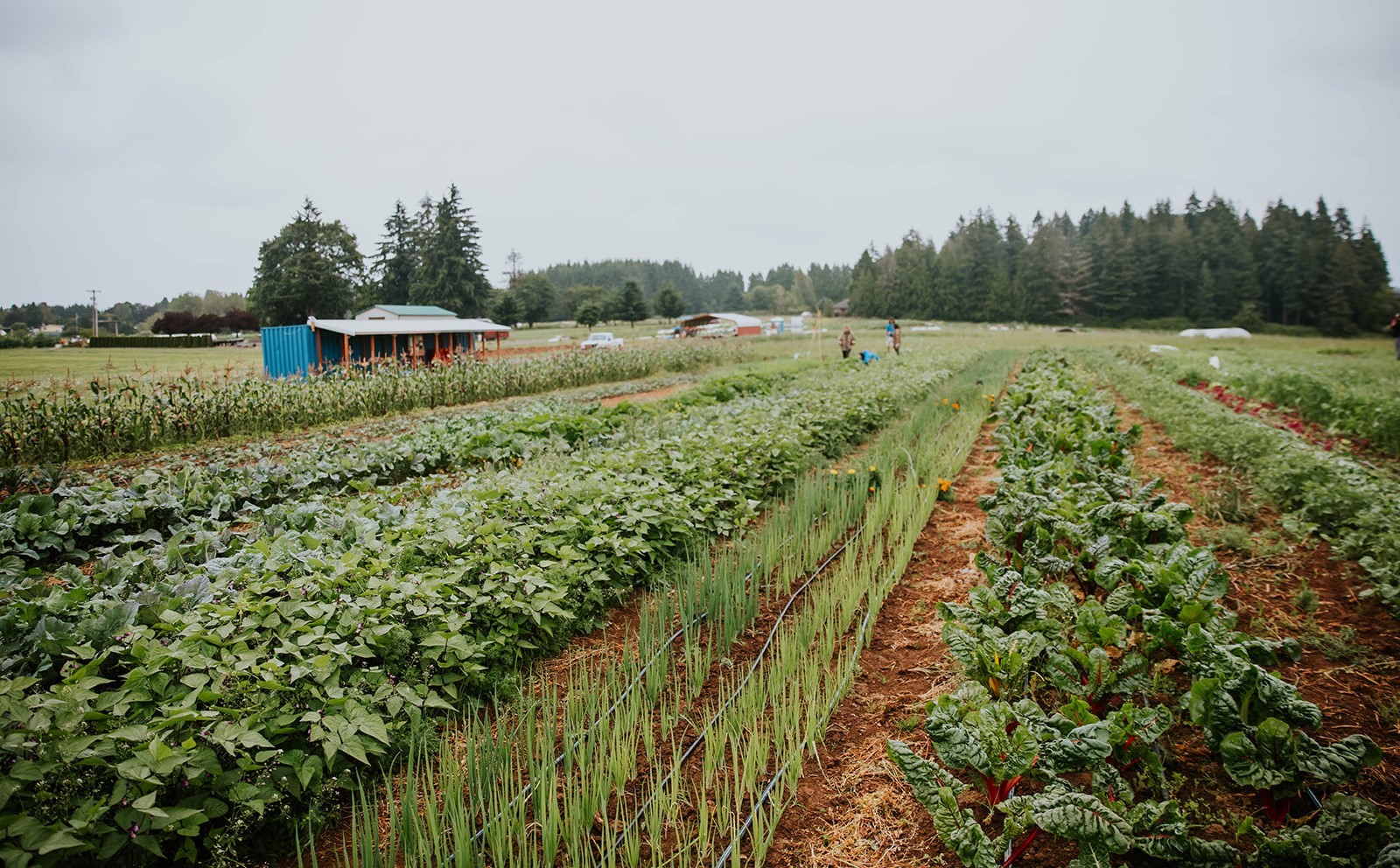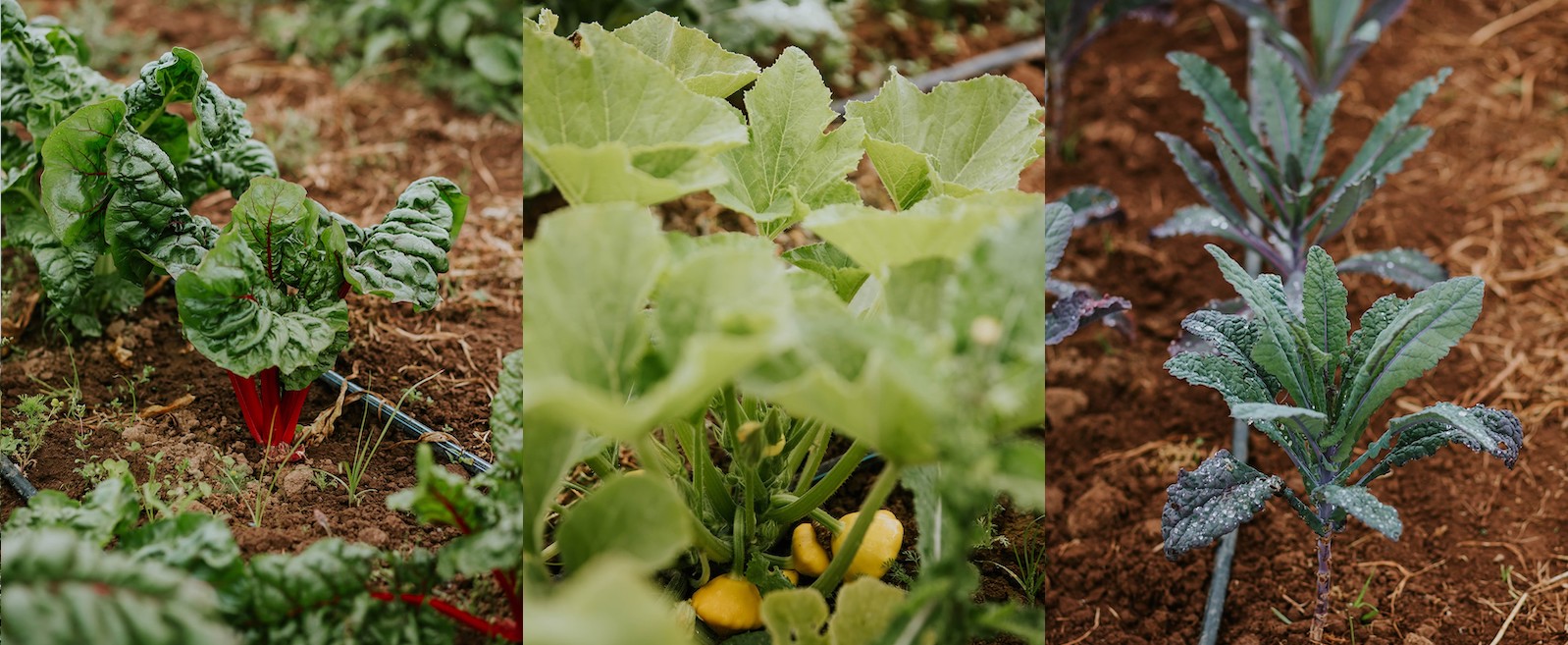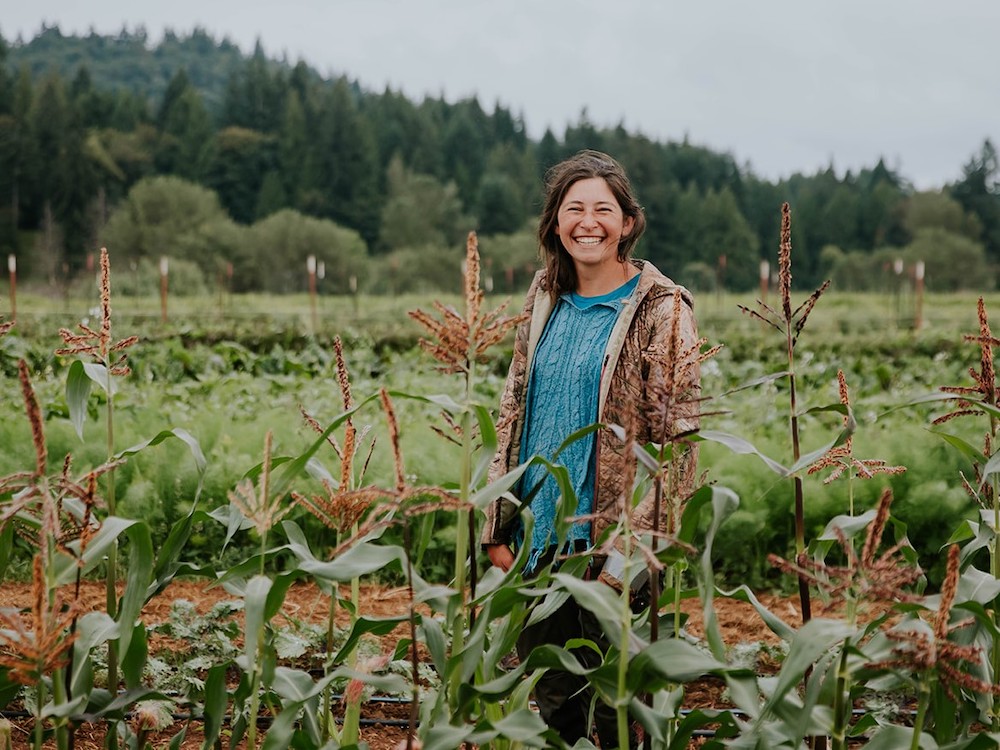Michelle Week isn’t interested in your garden variety veggies.
The owner of x̌ast sq̓it Good Rain Farm, based in the northern Willamette Valley, near Portland, Oregon, is focused on bringing traditional First Foods to her community. For her, these are foods that come with a story.
x̌ast sq̓it (pronounced “hast squeit”) translates to Good Rain in the traditional language of the sngaytskstx (Sinixt), the Arrow Lakes peoples.
Michelle is an Arrow Lakes and French descendant who comes from a long line of hunters, fishers and berry pickers. As a kid, she became president of her 4-H club after her habit of adopting animals ended up with her bringing home llamas. Despite this, Michelle says, “No one told me to be a farmer.” Instead, they suggested careers like veterinarian, botanist, landscape architect. “These nice titles to survive in capitalism.”
The farm began as a large garden, and it wasn’t until a restaurant approached her to buy her crops that Michelle thought, “Maybe I can do this as a full-time paying gig.” Now, she operates a two-acre Community Supported Agriculture, or CSA farm, that delivers produce such as lettuce, corn and tomatoes alongside traditional Pacific Northwest foods like salmonberries, wood sorrel and camas root. She also sells meat from rabbits that she raises.
Food justice and food sovereignty are foundations of Good Rain Farm, and 50 per cent of the farm’s produce is delivered free to the consumer to ensure all community members can access its fresh, local and traditional vegetables. With farming margins being so narrow, this is no easy feat. Michelle sat down with The Tyee to share, in her own words, how she’s made this happen, why it’s so important, and how it all stems from her own roots.

I grew up being told that I’m Native, but subversively was told not to talk about that identity publicly. I was taught as a young kid to suppress that identity. When we did some sales to that restaurant, I did some rebranding to focus on my personal identity. I found this dictionary of Okanagan Salish. I ended up with my grandmother and my mother and I was like, “I’m exploring our language. What do you think if I named the farm in our language?” If I’m going to be open about my identity, that means their identities are going to be more exposed. But they were really stoked about it.
I apprenticed at a CSA non-profit where I learned the nitty-gritty Excel sheets of running a farm operation. And then it was, unfortunately, a lot of hard work. And a few years of not getting paid, working a second job.
I rent land on a farm incubator right now. It is the Headwaters Incubator Program. It’s the only farmer incubator program for 400 miles. They subsidize your land access and provide fancy infrastructure. We have this big, beautiful pole barn where we store all of our tools. And there’s tractors you can rent and this whole equipment shed. You have up to five years of annually renewed leases. I farm on this land with five other farmers.
There are pollinator and native plant hedgerows throughout the farm. There’s a creek that runs through. There are beavers that live there. And the great blue herons nest way up in these trees like 200 feet. It’s wild watching these awkward lanky birds land in Douglas firs. Then they come down and they eat voles, moles and other pests. It’s a balanced ecological farming system.
Food stories
x̌ast sq̓it Good Rain Farm focuses primarily on Indigenous first group varieties from across Turtle Island. I select vegetables that are heirloom varieties — we’re all familiar with tomatoes or winter squashes but choosing particular varieties that have a connection to other tribal communities. So I grow Seminole pumpkins. I’m not Seminole. I’m not Muskogee. But bringing that in allows me to celebrate my community members who are and amplify that story. That is how I stay true to myself and bring in broader Native identities. Bringing in these different food stories and connecting that ancestry: that we are part of history in the past, and we are nurturing, and growing the future.
Even for the primarily white European descendant community members who engage with the farm. One of my favourite examples is where did we get carving pumpkins for Halloween? It came from Irish Celtic practices of carving turnips, beets, potatoes and radishes. They’re actually much creepier than pumpkins. And I love it. Sharing that along with Seminole pumpkins, or Hopi blue corn. Through our food stories, we are connected to these different generations.
My grandfather was the primary hunter and fisherman in our family. We always had a full freezer growing up. When he passed away, nine months after his funeral, the freezer was empty. And that hits you how big of a provider this person was. We didn’t have that anymore. It was go vegetarian or raise our own meat source. And so, I started raising rabbits.

Rabbits are low-impact critters. Rabbits really support ecosystems. They have awesome poop that you can directly apply to stuff. And they’re really efficient. They’re close to chickens in their feed-to-meat ratios. If you do it right, you can have the same amount of end-of-day meat as raising the cow on a quarter of the land.
I raise a particular breed of rabbit which is called the Champagne d’Argent. That’s a connection to my French ancestry. They’re really beautiful. They’re one of the oldest known domesticated rabbit breeds. There are some recent developed rabbit breeds for meat production, but this heritage breed still competes commercially with those others. And everyone all over the world has rabbits, they are really common. So that’s in everyone’s diets and traditional dishes.
Food justice
We do about 150 CSAs. We do a very traditional CSA box. I choose what goes in the box; they get what they get. My primary focus is the ancestry, that connection. You’re gonna get some weird, unique stuff, and I’m not going to apologize for it.
In addition, we do about 7,000 pounds of donated goods to non-profits. I target Indigenous non-profits and community efforts here in town. I do a lot of food equity work through the farm. We had started with “We’re gonna give away 50 per cent of the produce.” After the refocus, it just being me, it took about three years trying to figure out how I give away that produce so no one’s turned away for lack of funds, but I can pay my bills. For the last three years now, we have maintained roughly 50 per cent produce going free of charge to the end recipient.
I don’t do anything for free. Everything has a price tag. It’s just creative who’s footing the bill versus who’s receiving the goods. I do that through our payment pathways. I do a lot of grant writing and receive a lot of grants to support that work. We also have this three-tier sliding scale pricing scheme. It’s winged recently, but for the most part, those people who chose to pay above the market rate directly subsidize all those people who chose to pay below market rates. And then we offer payment plans to support people with cash flow, recognizing that having all that money up front can be hard for direct-to-consumer food boxes. I can accept government payment plans as well.
There’s no application for our scholarship funds. You just go to our website. If you can’t afford this, you punch in the scholarship coupon code. I don’t ask anyone to justify to me their need for food. Food should be free anyways.

‘Food is foundational’
The farm caused a lot of intergenerational healing and more openness with my family. I have all this ancestry and family trees, photographs my grandmother has gotten over the years, a bunch of books about our particular tribe. We’ve learned so much more, embraced so much more, a bit more honest about the painful parts of this.
I’ve got lots of emails like, “I haven’t had this food since I lived on the reservation. I haven’t gotten to have this food since my grandmother died.” So that’s really cool, to bring that back. Those are some of the stories of what impact has been made.
Food is foundational to our existence. Without food, you’re not going to be creative, you’re not going to recreate, you’re not going to have energy to advocate or engage in community. Food feels really foundational. And I think our society forgets. They’re just like shove it in. Who cares what it is?
We don’t value farmers for the intangible impact. For the impact they have on our water quality, or soil health, our air quality, all these other things that we do to build a more regenerative future for us all. That’s the hardest part of farming. You can be the best farmer on Earth, but climate change is really shaking shit up and your livelihood is on the line, because you only have produce as your tangible product to sell.
I think a lot of people have this cottage-core of what farming is; I call it the agrarian wet dream. The reality is those second jobs or other ways to pay the bills while building up the business is actually not that uncommon in farming. And that can be hard. I think that people feel like they’ve let themselves down where they’re not meeting a metric or expectation that doesn’t actually exist. So giving ourselves that space to practise forgiveness and flexibility and creativity: what really makes this possible and replicable. There are slow, incremental ways that you can build up to doing more impact, but it takes time.
I’m just so happy to be able to make space and encourage engagement. My ultimate favourite story: I had a CSA member and their young child. I was doing our summer drops. I haven’t been doing winter farming, so they switch farmers for winter CSA. So, the other farmer shows up and drops off. And the young child is like, “Who’s that dude?” And you’re like, “Well, that’s farmer Danny.” And the kid was like, “No, Michelle is our farmer.”
This article runs in a new section of The Tyee called ‘What Works: The Business of a Healthy Bioregion,’ where you’ll find profiles of people creating the low-carbon, sustainable economy we need from Alaska to California. Find out more about this project and its funders. ![]()
Read more: Indigenous, Food
















Tyee Commenting Guidelines
Comments that violate guidelines risk being deleted, and violations may result in a temporary or permanent user ban. Maintain the spirit of good conversation to stay in the discussion and be patient with moderators. Comments are reviewed regularly but not in real time.
Do:
Do not: